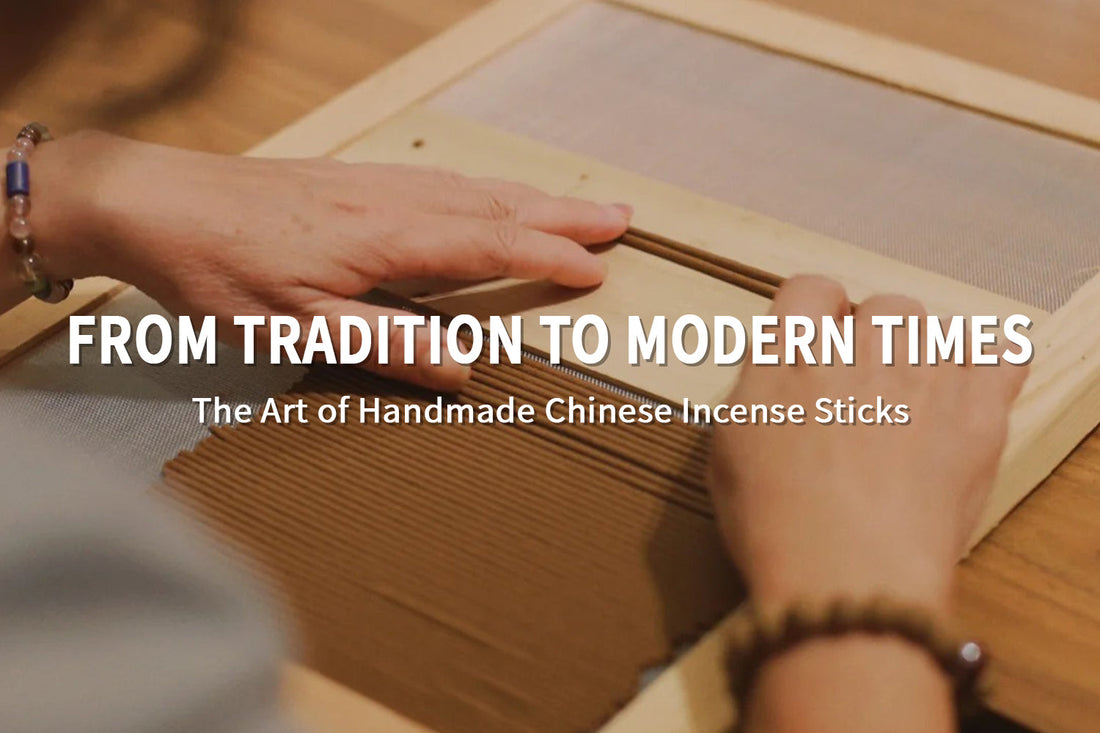
From Tradition to Modern Times: The Art of Handmade Chinese Incense Sticks
MasterBaiIn our last two articles, we explored the cultural depth of Chinese incense and its transformative role in meditation and daily life. But have you ever gazed at a slender stick of incense and wondered how it’s actually made? What secrets lie behind its steady flame?
Today, we’re going behind the scenes—into the very heart of Chinese incense-making. This journey takes us from the raw gifts of nature to the meticulous hands of artisans. It’s where ancient wisdom meets modern innovation. Once you understand this process, you’ll never light an incense stick the same way again—you’ll feel the craft and soul within every wisp of smoke.
1. The Craft of Handmade Chinese Incense
- Selection & Formula – This is the "recipe" stage, and it’s the soul of incense-making. Like skilled herbalists, incense masters carefully balance agarwood, sandalwood, and herbs according to the desired mood—whether calming, uplifting, or grounding.
- Grinding – Natural woods and herbs are ground into ultra-fine powders, ensuring smooth burning and gentle smoke.
- Mixing – The powders are blended with natural binders like tree bark powder and water. Through hand-kneading and pressing, a soft, consistent dough-like mixture is created. This step is critical—poor mixing leads to broken incense or uneven burning.
- Forming – The incense dough is shaped. Some use traditional hand-rolling, while others extrude it through copper molds for perfectly straight sticks. Both require precision and patience.
- Drying – The incense is carefully air-dried in a dust-free, shaded environment for several days, with frequent turning to prevent warping.
- Aging – Just like wine or tea, incense improves with time. Stored in clay jars, the fragrance blends and matures over months—or even years—becoming richer, smoother, and more layered.
2. Tradition Meets Modern Innovation
- Tradition: The philosophy of harmony with nature, the wisdom of ancient formulas, and the artisan’s intuition remain at the core.
- Modern Methods: Technology ensures finer grinding, precise drying, and fragrance analysis—helping artisans refine blends and maintain safety standards.
The best incense today honors its roots while using innovation to make this ancient art sustainable and trustworthy.
3. Why Handmade Incense Feels Different?
- Living Aroma: Hand-kneading creates a texture that allows the scent to "breathe" as it burns, giving the fragrance more depth and variation.
- Artisan’s Spirit: Each batch reflects the artisan’s touch, shaped by subtle factors like temperature, humidity, and mood. No two are exactly alike.
- Cultural Legacy: Buying handmade incense supports not just a product, but an artisan, a craft, and centuries of living culture.
4. How to Recognize Quality Incense
- If you’re shopping for incense sticks, here’s what to look for:
- Transparent ingredients – Labels should clearly state natural woods and herbs. Avoid “fragrance oils” or synthetic additives.
- Natural appearance – Handmade incense sticks may look less uniform but carries an authentic, earthy color. Bright colors often mean chemicals.
- Balanced burn – A good stick burns evenly, with soft white smoke that’s gentle on the eyes and lungs.
- Pure aroma – The scent should feel calming or uplifting, never harsh, dizzying, or overwhelming.
| Chemical Incense | Natural Handmade Incense | |
| Ingredients | Fragrance oils, dyes, additives | Woods, herbs, resins, natural binders |
| Smoke | Thick, dark, irritating | Soft, white, soothing |
| Scent | Harsh, overpowering, causes dizziness | Rich, layered, comforting |
| Touch | Artificially smooth, may leave residue | Textured, natural feel |
| Ash | Hard, black, hot | Fine, white, cool to touch |
5. The Natural Spices of Chinese Incense Sticks
- Flowers: Jasmine, osmanthus, rose—sweet and romantic.
- Herbs: Mugwort, patchouli, nard—cleansing and calming.
- Resins: Frankincense, myrrh—deep, resinous, and ceremonial.
- Spices & fruits: Clove, star anise—warm, spicy accents.
6. Simple Tests for True Quality
- Look at the smoke: Natural incense produces fine, pale smoke that rises gently.
- Touch the ash: Natural incense ash cools quickly and feels soft, unlike chemical incense, which stays hot.
- Smell the scent: It should feel natural, soothing, and pleasant—not sharp or synthetic.
7. The Art of Blending
- Base note (foundation): e.g., sandalwood or agarwood.
- Middle note (support): e.g., frankincense to add sweetness.
- Top note (accent): e.g., jasmine or mint for brightness.
8. Handmade Incense as a Living Heritage
Every handcrafted stick carries history. Some formulas date back to ancient dynasties, blending medicine, art, and philosophy. Owning handmade incense means holding a piece of living tradition—a story you can light, breathe, and experience.
9. What Incense That Matches You?
- Grounded & reflective: Agarwood, old mountain sandalwood.
- Warm & nurturing: Creamy sandalwood, frankincense.
- Fresh & lively: Jasmine, osmanthus, citrus blends.
10. Why Handmade Incense Is Collectible?
Like fine wine or aged tea, premium incense grows more complex with time. Limited artisan batches—especially those made with rare agarwood—carry both cultural and collectible value, cherished by connoisseurs worldwide.
